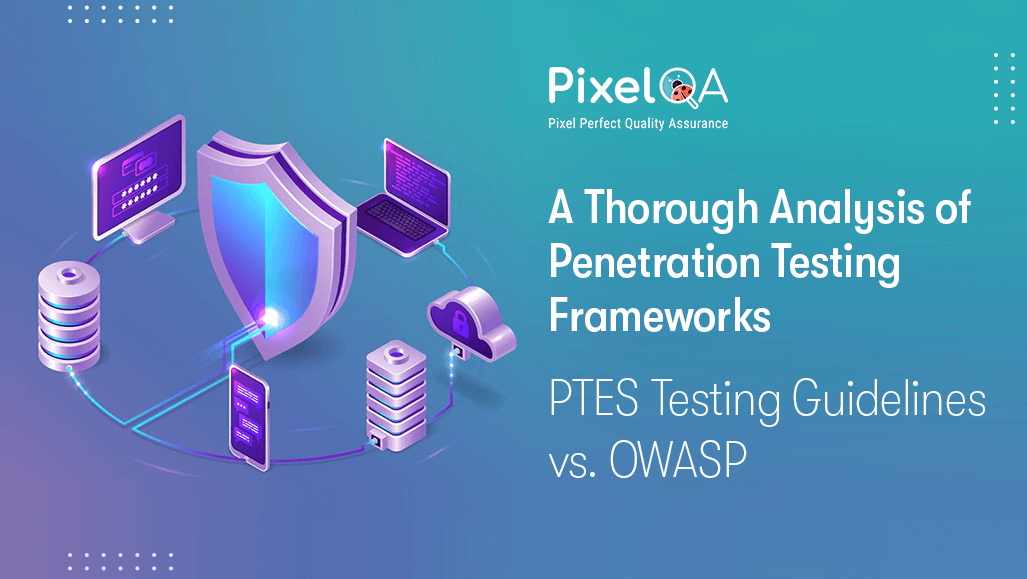
Introduction:
Penetration testing is an essential method in cybersecurity. Specialists launch an attack on the framework to uncover flaws that offenders can exploit in the short term. The OWASP Testing Guide and the PTES (Penetration Testing Execution Standard) are two of the most widely used penetration testing tools available. Both of these frameworks are widely acknowledged by the cybersecurity community and are often leveraged by top-tier Penetration Testing Services providers. Nonetheless, their techniques, use cases, and areas of expertise are distinct. In this online journal entry, we will look at the primary highlights, benefits, challenges, and circumstances where the OWASP and PTES testing guides are most useful.
Table of Contents
- What is the OWASP Testing Guide?
- Key Features of the OWASP Testing Guide:
- Pros of the OWASP Testing Guide:
- Cons of the OWASP Testing Guide:
- What are PTES?
- Key Features of PTES:
- Pros of PTES:
- Cons of PTES:
- OWASP Testing Guide vs PTES: Key Differences
- Which Framework Should You Choose?
- Conclusion
What is the OWASP Testing Guide?
The OWASP Test Development Project is open source, a project of the Open Web Application Security Project (OWASP) aimed at improving software security. The core focus of the OWASP Testing Guide is web application security. The goal of this methodical technique is to assist penetration analysts in evaluating online application security.
Key Features of the OWASP Testing Guide:
- Focused on Web Applications: The OWASP Testing Guide is aimed explicitly at testing online application security. Therefore, when testing a website or web application, this guide illustrates the methods to find vulnerabilities such as Cross-Site Scripting (XSS), SQL injection, and insecure authentication schemes.
- Comprehensive Structure: The guide is segregated into more than one section in which embodies a singular aspect of the security of web applications. These sections vary from gathering records about the goal internet utility to figuring out vulnerabilities, testing business judgment flaws, and in the end, exploiting those weaknesses.
- Open Source: The test guide is free and open source as part of OWASP. It is continuously updated by a large community of security experts. This makes it the most reliable resource for penetration testers.
- Tools and Techniques: It describes the receptacle and recommends apparatus and methods for conducting penetration tests. Example equipment such as Burp Suite, OWASP ZAP, and Nmap serve as excellent allies in the work of expert testers for automating and improving productivity.
Pros of the OWASP Testing Guide:
1. Web Application-Focused: The businesses with a big web face will find that the OWASP Testing Guide is an ideal framework for the adoption of an application-testing framework specifically defined for web-based applications. It is good for testing the security of websites and their online services.
2. Clear and Structured: The methods are well organized, making them easy to follow. Even those who are new to security penetration testing can understand the concepts and steps of the testing process.
3. Community Support: since OWASP is a huge and dynamic organization. Regular updates and modifications will improve the testing guide. This indicates that it is still applicable in the dynamic field of application and web security.
4. Wide Adoption: OWASP has become the standard in the industry. That is, this framework is already known to many businesses. Also, by employing OWASP's recommendations, industries would be aligned with the best practices of penetration testers.
Cons of the OWASP Testing Guide:
1. Limited Scope:Web application security is the focus of the OWASP Testing Guide. Despite this, it offers excellent insights for evaluating web services and websites. However, it isn't helpful for web browser-focused penetration testing. Applications for mobile devices and other settings That isn't a webpage.
2. Complexity: The manual contains some technical and thorough chapters. Beginners find it challenging to follow because of this. It could occasionally be too much for inexperienced testers to handle.
What are PTES?
Another often-used framework in the security penetration testing industry is the Penetration Testing Performance Standard (PTES). PTES offers a broad approach to penetration testing, which sets it apart from the OWASP testing recommendations. This covers a broad range of circumstances. network, system, and physical security in addition to online applications.
Key Features of PTES:
- Comprehensive Methodology: PTES outlines the complete penetration testing cycle. It starts with participation and scope. to collecting information Vulnerability analysis exploitation post-exploitation and reporting This is not limited to web applications. But it also extends to all types of penetration testing. This includes a physical assessment of the network.
Seven Phases: PTES divides the penetration testing process into seven phases:
- Pre-engagement Interactions: This stage determines the scope, goals, and rules for carrying out the research.
- Information Gathering: To better understand the target framework's engineering and potential vulnerabilities, testers gather data about it.
- Threat Modeling: Determining the most likely threats and points of attack.
- Vulnerability Analysis: Looking for known vulnerabilities in the framework.
- Exploitation: Attempting to gain access to the framework by abusing vulnerabilities.
- Post-exploitation: Figuring out how much has been picked up and continuing to work tirelessly on the system.
- Reporting: The job is to document findings and counseling on tackling issues discovered.
Flexibility: Now, there is an increased operational versatility of the PTES; whether testing social engineering, surveying a business application, or auditing web applications, it may be used for the penetration-testing methodology.
Pros of PTES:
- Broad Coverage: The scope of penetration testing covered by PTES is far wider than that of the OWASP testing methodology. Network infrastructure is a part of this. PTES is the best option for people performing comprehensive penetration testing that addresses a variety of security domains, including operating systems, physical security, and even social engineering assaults.
- Full Lifecycle Approach: The Penetration Testing Execution Standard covers all aspects of penetration testing, including planning, engagement, exploitation, and reporting. It will greatly benefit penetration testers as it offers a structured, comprehensive framework for the entire process.
- Adaptability: This adaptable and very flexible way can be put to use for different types of tests. Hence, practicing testers can alter their approaches according to client-specific needs or characteristics of an expected assignment.
Cons of PTES:
- Not Web Application-Specific: PTES, however, is far more of a general framework and does not have the same specificity when it comes to testing for online applications as the OWASP Testing Guide. Specifically with respect to web applications, PTES does not touch on the levels of depth that OWASP goes into.
- Complex for Beginners: PTES is a sophisticated methodology that necessitates a solid understanding of penetration testing. Beginners may have difficulty following along. It covers a wide range of topics, which might be overwhelming for individuals new to the sector.
OWASP Testing Guide vs PTES: Key Differences
Scope:
- OWASP Testing Guide: Mostly concerned with online apps.
- PTES: Covers a wide range of penetration testing scenarios. including network security, Physical security and more
Methodology:
- OWASP Testing Guide: Provides detailed methods for testing specific web applications. Detailed breakdown of each type of vulnerability and testing techniques.
- PTES: Provides general guidance covering the entire penetration testing cycle. Including creating hazard models after exploitation and reporting.
Community Support:
- OWASP Testing Guide: OWASP maintains it, with frequent updates and strong community participation.
- PTES: Though not as actively maintained as OWASP, it is nevertheless a well-accepted and large framework.
Tools and Resources:
- OWASP Testing Guide: Frequently asked questions on particular web application testing technologies, like OWASP ZAP and Burp Suite.
- PTES: Provides a more general approach without specific tooltips. It allows the tester to choose the tool according to the scope of the test.
Which Framework Should You Choose?
Whether you use PTES or the OWASP Testing Guide will depend on the type of penetration testing you are conducting:
- For Web Application Penetration Testing: If your primary concern is online application security, the OWASP Test Guide is a good choice. It offers comprehensive and current instructions on how to test for vulnerabilities in web applications. and is generally acknowledged in the field.
- For Broader Penetration Testing Needs: If your penetration test covers a broad scope, including network infrastructure, physical security or testing the PTES system would be more appropriate. Its flexible and comprehensive approach allows you to adapt to a variety of testing situations.
Conclusion
The OWASP and the PTES Testing Guides are very valuable in terms of penetration testing. They have most of what a Software Testing Compnay would need to augment its testing procedures. Web application security is highlighted in the OWASP Testing Guide, offering a methodical way to test common vulnerabilities. However, PTES provides a more thorough and adaptable framework for carrying out extensive penetration testing across industries.
Ultimately, your unique penetration testing requirements will determine which of these frameworks is best for you. For web-centric testing, the OWASP Test Guide is a useful tool; however, testers seeking a more flexible method may prefer PTES. Which framework you select is irrelevant—both are effective ways to guarantee the security of systems and networks in today’s changing threat landscape.
About Author

Rushi Mistry is a Security Tester at PixelQA with a focus on cybersecurity. He is passionate about IoT penetration testing and is working towards obtaining a CISSP certification, with the ultimate goal of becoming a Chief Information Security Officer (CISO).

_638702021789868752.png)